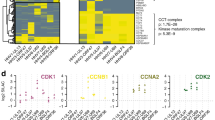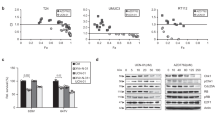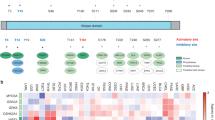Abstract
The passage of mammalian cells through the restriction point into the S phase of the cell cycle is regulated by the activities of Cdk4 and Cdk6 complexed with the D-type cyclins and by cyclin E/Cdk2 (refs 1,2,3). The activities of these holoenzymes are constrained by CDK inhibitory proteins4,5. The importance of the restriction point is illustrated by its deregulation in many tumour cells6,7 and upon infection with DNA tumour viruses8. Here we describe the properties of cyclins encoded by two herpesviruses, herpesvirus saimiri (HVS) which can transform blood lymphocytes9 and induce malignancies of lymphoid origin in New World primates9,10, and human herpesvirus 8 (HHV8) implicated as a causative agent of Kaposi's sarcoma and body cavity lymphomas11,12. Both viral cyclins form active kinase complexes with Cdk6 that are resistant to inhibition by the CDK inhibitors p16Ink4a, p21Cip1and p27Kip1. Furthermore, ectopic expression of a viral cyclin prevents G1 arrest imposed by each inhibitor and stimulates cell-cycle progression in quiescent fibroblasts. These results suggest a new mechanism for deregulation of the cell cycle and indicate that the viral cyclins may contribute to the oncogenic nature of these viruses.
This is a preview of subscription content, access via your institution
Access options
Subscribe to this journal
Receive 51 print issues and online access
$199.00 per year
only $3.90 per issue
Buy this article
- Purchase on Springer Link
- Instant access to full article PDF
Prices may be subject to local taxes which are calculated during checkout



Similar content being viewed by others
References
Sherr, C. J. Mammalian G1 cyclins. Cell 73, 1059–1065 (1993).
Weinberg, R. A. The retinoblastoma protein and cell cycle control. Cell 81, 323–330 (1995).
Sherr, C. J. Cancer cell cycles. Science 274, 1672–1677 (1996).
Sherr, C. J. & Roberts, J. M. Inhibitors of mammalian G1 cyclin-dependent kinases. Genes Dev. 9, 1149–1163 (1995).
Harper, J. W. & Elledge, S. J. Cdk inhibitors in development and cancer. Curr. Opin. Genet. Dev. 6, 56–64 (1996).
Hall, M. & Peters, G. Genetic alterations of cyclins, cyclin-dependent kinases, and cdk inhibitors in human cancer. Adv. Cancer Res. 68, 67–108 (1996).
Strauss, M., Lukas, J. & Bartek, J. Unrestricted cell cycling and cancer. Nature Med. 1, 1245–1246 (1996).
Nevins, J. R. Cell cycle targets of the DNA tumor viruses. Curr. Opin. Genet. Dev. 4, 130–134 (1994).
Biesinger, B. et al. Stable growth transformation of human T lymphocytes by herpesvirus saimiri. Proc. Natl Acad. Sci. USA 89, 3116–3119 (1992).
Fleckenstein, B. & Desrosiers, R. C. in The herpesviruses Vol. 1(ed. Roizman, B.) 252–332 (Plenum, New York, (1982)).
Chang, Y. et al. Identification of herpesvirus-like DNA sequences in AIDS-associated Kaposi's sarcoma. Science 266, 1865–1869 (1994).
Cesarmen, E. et al. Kaposi's sarcoma-associated herpesvirus-like DNA sequences in AIDS-related body-cavity-based lymphomas. N. Engl. J. Med. 332, 1186–1191 (1995).
Jung, J. U., Stager, M. & Desrosiers, R. C. Virus encoded cyclin. Mol. Cell. Biol. 14, 7235–7244 (1994).
Chang, Y. et al. Cyclin encoded by KS herpesvirus. Nature 382, 410 (1996).
Meyerson, M. & Harlow, E. Identification of G1 kinase activity for cdk6, a novel cyclin D partner. Mol. Cell. Biol. 14, 2077–2086 (1994).
Toyoshima, H. & Hunter, T. p27, a novel inhibitor of G1 cyclin-Cdk protein kinase activity, is related to p21. Cell 78, 67–74 (1994).
Hall, M., Bates, S. & Peters, G. Evidence for different modes of action of cyclin-dependent kinase inhibitors: p15 and p16 bind to kinases, p21 and p27 bind to cyclins. Oncogene 11, 1581–1588 (1995).
Chen, J. et al. Cyclin binding motifs are essential for the function of p21Cip1. Mol. Cell. Biol. 16, 4673–4682 (1996).
Lin, J., Reichner, C., Wu, X. & Levine, A. J. Analysis of wild-type and mutant p21 WAF-1 gene activities. Mol. Cell. Biol. 16, 1786–1793 (1996).
Russo, A. A., Jeffrey, P. D., Patten, A. K., Massague, J. & Pavletich, N. P. Crystal structure of the p27Kip1 cyclin-dependent-kinase inhibitor bound to the cyclin A-Cdk2 complex. Nature 382, 325–331 (1996).
Resnitzky, D. & Reed, S. I. Different roles for cyclin D1 and E in regulation of the G1-to-S transition. Mol. Cell. Biol. 15, 3463–3469 (1995).
Mann, D. J. & Jones, N. E2F-1 but not E2F-4 can overcome p16-induced cell cycle arrest. Curr. Biol. 6, 474–483 (1996).
Ohtsubo, M. et al. Human cyclin E, a nuclear protein essential for the G1-to-S phase transition. Mol. Cell. Biol. 15, 2612–2624 (1995).
Roussel, R. et al. Rescue of defective mitogenic signalling by D-type cyclins. Proc. Natl Acad. Sci. USA 92, 6837–6841 (1995).
Kato, J. M. et al. Direct binding of cyclin D to the retinoblastoma gene product (pRb) and pRb phosphorylation by the cyclin D-dependent kinase CDK4. Genes Dev. 7, 331–342 (1993).
Acknowledgements
We thank C. Sherr and M. Meyerson for gifts of baculovirus recombinants. We thank M. Hall for technical advice on the cyclin-inhibitor binding assay and for providing purified inhibitor proteins. We also thank D. Davies and C. Hughes for help with FACS analysis, G. Clark and A.Davies for sequencing analysis, and G. Card and N. McDonald for advice and encouragement throughout the study. This study was funded by the Imperial Cancer Research Fund. C.S. is supported by University College London Medical School and F.N. by the ‘Deutsche Krebsforschungstifftung founded by Mildred Scheel’ foundation.
Author information
Authors and Affiliations
Corresponding author
Rights and permissions
About this article
Cite this article
Swanton, C., Mann, D., Fleckenstein, B. et al. Herpes viral cyclin/Cdk6 complexes evade inhibition by CDK inhibitor proteins. Nature 390, 184–187 (1997). https://doi.org/10.1038/36606
Received:
Accepted:
Issue Date:
DOI: https://doi.org/10.1038/36606
This article is cited by
-
Nm23-H1 induces apoptosis in primary effusion lymphoma cells via inhibition of NF-κB signaling through interaction with oncogenic latent protein vFLIP K13 of Kaposi’s sarcoma-associated herpes virus
Cellular Oncology (2022)
-
Cyclin-dependent kinases and CDK inhibitors in virus-associated cancers
Infectious Agents and Cancer (2020)
-
Latent infection with Kaposi’s sarcoma-associated herpesvirus enhances retrotransposition of long interspersed element-1
Oncogene (2019)
-
Gene essentiality landscape and druggable oncogenic dependencies in herpesviral primary effusion lymphoma
Nature Communications (2018)
-
Cellular and viral oncogenes: the key to unlocking unknowns of Kaposi’s sarcoma-associated herpesvirus pathogenesis
Archives of Virology (2018)
Comments
By submitting a comment you agree to abide by our Terms and Community Guidelines. If you find something abusive or that does not comply with our terms or guidelines please flag it as inappropriate.



